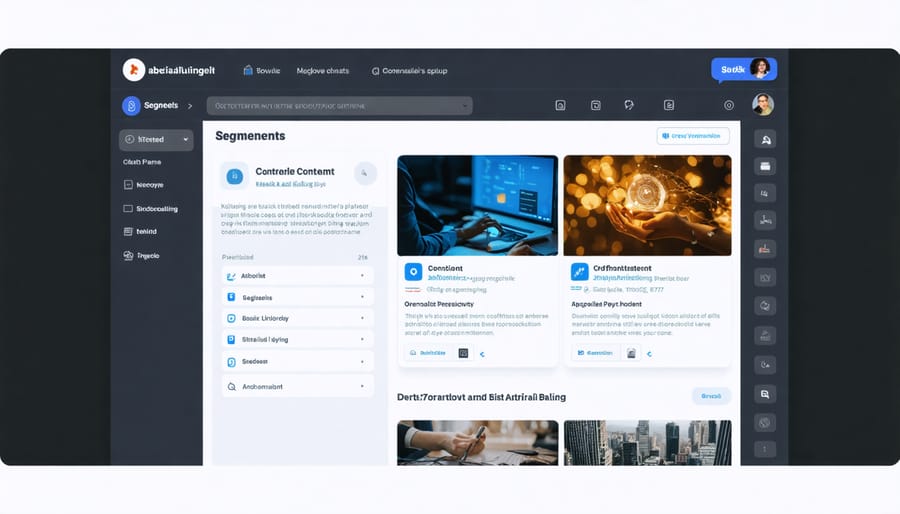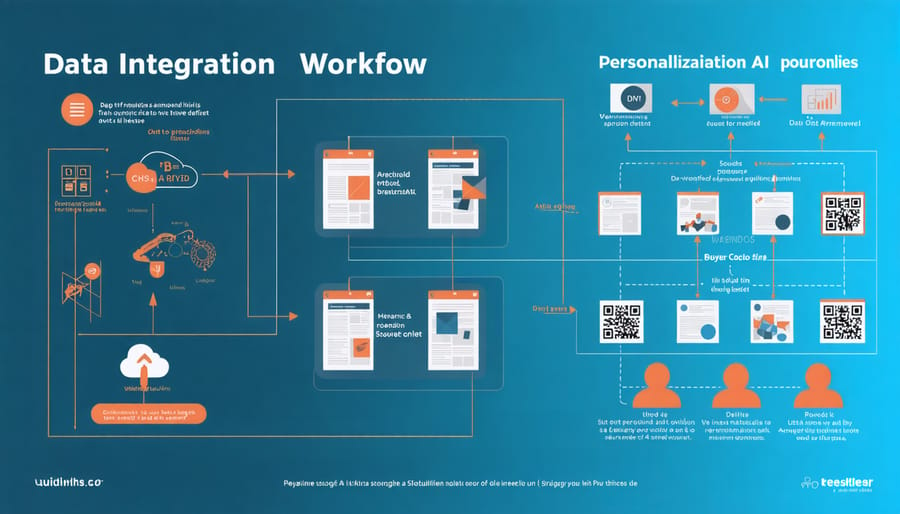AI Personalization Is Transforming B2B Content (Here’s How)

AI-driven personalization is revolutionizing how businesses connect with their customers, transforming generic marketing approaches into precision-targeted experiences that drive engagement and conversion. By leveraging machine learning algorithms and predictive analytics, companies now customize everything from email campaigns to website content in real-time, delivering exactly what each customer needs, when they need it.
Recent studies show that businesses implementing AI-driven personalization see up to 40% higher revenue and a 50% increase in customer satisfaction compared to those using traditional segmentation methods. This isn’t just about showing relevant products – it’s about creating dynamic, responsive customer journeys that evolve with each interaction.
For B2B marketers, the stakes are particularly high. With complex sales cycles and multiple decision-makers involved, AI personalization offers unprecedented opportunities to tailor content and communications across entire buying committees. The technology now exists to analyze thousands of data points instantly, predicting customer needs and automatically adjusting messaging to match each stage of the buyer’s journey.
As we move into an era where personalization isn’t just preferred but expected, organizations that master AI-driven customer experiences will gain a significant competitive advantage. The question isn’t whether to implement AI personalization – it’s how quickly and effectively you can deploy it to stay ahead of the curve.
How AI Powers Modern B2B Content Personalization
Machine Learning and Behavioral Analysis
AI-driven personalization relies heavily on sophisticated machine learning algorithms that continuously analyze and interpret user behavior patterns. These systems track multiple interaction points, including page views, click-through rates, time spent on content, and conversion actions. By processing this data in real-time, AI can identify patterns and preferences that might not be immediately apparent to human analysts.
The behavioral analysis process works on multiple levels. First, it categorizes users based on their demographic information and initial interactions. Then, it tracks micro-behaviors such as scroll depth, mouse movements, and interaction frequency to build detailed user profiles. These profiles become more refined over time as the system gathers more data points and identifies correlations between different behaviors and outcomes.
What makes this approach particularly powerful is its ability to adapt and evolve. As user behaviors change or new patterns emerge, the AI automatically adjusts its recommendations and personalization strategies. This dynamic learning process ensures that content and experiences remain relevant and engaging, even as market conditions and consumer preferences shift.
For businesses, this translates into more precise targeting, improved customer engagement, and higher conversion rates through continuously optimized personalization strategies.

Natural Language Processing in Content Adaptation
Natural Language Processing (NLP) serves as the cornerstone of effective content personalization by enabling AI systems to understand, interpret, and generate human language naturally. This technology analyzes customer communications, feedback, and content preferences across multiple channels to create more relevant and engaging experiences.
In practice, NLP algorithms examine text data from various sources, including customer emails, chat interactions, and social media posts, to identify patterns in language use, sentiment, and topic preferences. This analysis helps businesses deliver content that resonates with specific audience segments by matching tone, complexity, and subject matter to individual preferences.
For example, when a customer consistently engages with technical product reviews, the system can automatically adjust content delivery to include more detailed specifications and expert analysis. Similarly, if analytics show a preference for casual, conversational content, the AI can modify the writing style accordingly.
The real power of NLP in content adaptation lies in its ability to scale personalization efforts without sacrificing quality. By automatically processing and understanding natural language inputs, businesses can maintain personalized communications with thousands of customers simultaneously, ensuring each interaction feels genuine and relevant.
Real-World Applications in B2B Marketing
Dynamic Website Content
AI-driven personalization transforms static websites into dynamic experiences that adapt to each B2B visitor’s unique characteristics and behavior patterns. By analyzing data points such as company size, industry vertical, browsing history, and engagement patterns, AI systems automatically adjust content, messaging, and offers in real-time.
When a visitor arrives at your website, AI algorithms immediately begin processing their digital footprint. This includes their referral source, geographic location, and device type. For returning visitors, the system incorporates historical interaction data to create an even more tailored experience. Key elements like headlines, case studies, product recommendations, and CTAs are dynamically adjusted to match the visitor’s profile and interests.
For example, a manufacturing executive might see industry-specific success stories and ROI calculators, while a technology sector visitor receives content focused on integration capabilities and scalability metrics. This intelligent content delivery significantly improves engagement rates and conversion potential by ensuring visitors encounter the most relevant information for their specific business context.
The system continuously learns from visitor interactions, refining its personalization strategies to deliver increasingly targeted experiences that resonate with different B2B buyer personas.

Email Marketing Automation
AI-driven email marketing automation is revolutionizing how B2B companies engage with their prospects and clients. By leveraging advanced machine learning algorithms, B2B marketing automation platforms can now analyze recipient behavior, preferences, and engagement patterns to deliver highly personalized email campaigns.
These AI systems excel at segmenting email lists based on multiple data points, including industry vertical, company size, past interactions, and purchase history. The technology automatically adjusts send times, subject lines, and content based on individual recipient engagement patterns, significantly improving open rates and click-through rates.
Smart automation tools can now predict the most effective email sequences, recommend optimal content placement, and even generate personalized subject lines that resonate with specific audience segments. For example, AI can automatically customize product recommendations based on a client’s browsing history or adjust the email’s tone to match the recipient’s communication style.
The real power lies in the system’s ability to continuously learn and adapt. As more data is collected, the AI refines its understanding of what works for different audience segments, creating increasingly effective personalized campaigns over time.
Account-Based Marketing Enhancement
AI technology is revolutionizing how businesses approach account-based marketing strategies, enabling more precise targeting and personalized content delivery at scale. By leveraging machine learning algorithms, companies can now analyze vast amounts of customer data to identify high-value accounts and create hyper-personalized experiences for key decision-makers.
These AI-powered systems excel at identifying patterns in customer behavior, company firmographics, and engagement metrics to predict which accounts are most likely to convert. This intelligence allows marketing teams to allocate resources more effectively and create tailored content that resonates with specific account profiles.
The enhancement of ABM through AI manifests in several key areas:
– Automated account scoring and prioritization
– Real-time content customization based on account behavior
– Predictive analytics for account selection
– Dynamic website personalization for target accounts
– Intelligent content recommendations across channels
By implementing AI-driven personalization in ABM, businesses typically see improved engagement rates, shorter sales cycles, and higher conversion rates. The technology helps eliminate guesswork by providing data-backed insights about account preferences and pain points, enabling marketing teams to craft more relevant and compelling messages.
For optimal results, organizations should focus on integrating AI tools that complement their existing ABM infrastructure while maintaining a human touch in relationship building and strategic decision-making.
Implementation Strategies That Work

Data Collection and Integration
Effective AI-driven personalization relies heavily on quality data collection and seamless integration across multiple touchpoints. The foundation begins with gathering three essential types of data: demographic information, behavioral data, and contextual insights. Businesses should focus on collecting customer interaction data from various sources, including website visits, email engagement, social media activity, and purchase history.
To ensure successful data integration, organizations need to establish a unified customer data platform (CDP) that consolidates information from different channels. This centralized approach enables real-time data processing and creates a comprehensive customer profile that AI systems can utilize effectively.
Key data collection considerations include:
– Implementation of tracking pixels and analytics tools
– Integration of CRM systems with marketing platforms
– Collection of first-party data through forms and surveys
– Monitoring of customer service interactions
– Analysis of social media engagement metrics
When integrating these data sources, it’s crucial to maintain data quality and ensure compliance with privacy regulations. Organizations should implement data validation processes and regular audits to maintain accuracy. Additionally, establishing clear data governance policies helps protect customer information while enabling effective personalization.
For optimal results, businesses should prioritize real-time data collection capabilities and ensure their integration infrastructure can handle large volumes of information without compromising system performance or data accuracy.
Measuring Success and ROI
Measuring the success of AI-driven personalization requires a comprehensive approach focused on both quantitative metrics and qualitative indicators. Start by tracking conversion rates across personalized customer segments compared to non-personalized experiences. Key performance indicators (KPIs) should include click-through rates, engagement time, and customer lifetime value (CLV).
Return on Investment (ROI) can be calculated by comparing the cost of implementing and maintaining AI personalization systems against the increased revenue from improved conversion rates and customer retention. Track metrics like average order value (AOV) and purchase frequency to measure direct financial impact.
Customer satisfaction metrics are equally important. Monitor Net Promoter Score (NPS), customer satisfaction (CSAT) scores, and customer feedback to gauge the effectiveness of your personalization efforts. Pay attention to reduced bounce rates and increased time on site as indicators of improved user experience.
For B2B contexts, measure lead quality scores, sales cycle duration, and deal closure rates. Analytics tools can help track these metrics while providing insights into customer behavior patterns and preferences.
Set clear benchmarks before implementation and regularly review performance against these baselines. Consider both short-term gains and long-term benefits when evaluating success. Remember that effective measurement requires continuous monitoring and adjustment of your personalization strategy based on collected data and insights.
Common Challenges and Solutions
Data Privacy and Compliance
As AI-driven personalization becomes more sophisticated, businesses must carefully navigate data privacy regulations and maintain compliance while delivering personalized experiences. The implementation of robust data protection measures is essential for building trust with customers and avoiding potential legal issues.
Start by conducting regular privacy impact assessments to identify and address potential risks in your personalization strategy. Ensure your data collection practices align with GDPR, CCPA, and other relevant regional regulations by implementing clear consent mechanisms and maintaining detailed records of data processing activities.
Key compliance measures should include:
– Transparent privacy policies that clearly explain how customer data is collected and used
– Opt-in/opt-out mechanisms for personalization features
– Secure data storage and encryption protocols
– Regular audits of data handling practices
– Employee training on privacy compliance
Consider implementing privacy-by-design principles in your personalization strategy. This approach integrates privacy considerations from the beginning rather than treating them as an afterthought. Use data minimization techniques, collecting only the information necessary for your personalization goals.
Remember to regularly update your compliance frameworks as regulations evolve and new privacy laws emerge. Working with legal experts who specialize in digital privacy can help ensure your AI-driven personalization efforts remain compliant while delivering value to your customers.
Integration with Existing Systems
Successful implementation of AI-driven personalization requires thoughtful marketing technology integration with your existing systems. Start by conducting a comprehensive audit of your current tech stack, identifying key touchpoints where personalization can add value. Most modern CRM systems, email marketing platforms, and content management systems offer APIs or native integration capabilities that can connect with AI personalization tools.
Consider implementing a middleware solution if your existing systems don’t directly support AI integration. This approach creates a bridge between legacy systems and new AI capabilities without disrupting current operations. Popular middleware options include customer data platforms (CDPs) that can unify data from multiple sources and make it accessible to AI engines.
Prioritize systems that handle customer data, as these will form the foundation of your personalization efforts. Ensure your integration strategy includes:
– Data synchronization protocols
– Real-time update capabilities
– Automated workflow triggers
– Security compliance measures
– Performance monitoring tools
Start with small-scale integrations in non-critical areas to test effectiveness and iron out any issues. Gradually expand the implementation across your marketing stack as you validate results and build team confidence. Remember to document all integration points and maintain clear communication channels between technical teams and marketing stakeholders to ensure smooth operations.
AI-driven personalization represents a transformative approach to modern marketing, offering unprecedented opportunities for businesses to connect with their audiences on a deeper level. As we’ve explored throughout this article, successful implementation requires a strategic blend of data analytics, customer insights, and the right technological infrastructure.
To begin your AI personalization journey, start by auditing your current data collection practices and establishing clear objectives. Focus on gathering quality customer data while ensuring compliance with privacy regulations. Next, select appropriate AI tools that align with your business goals and budget, beginning with smaller pilot projects before scaling up.
Remember that personalization is an iterative process. Regularly monitor your KPIs, gather feedback, and refine your approach based on real-world results. Pay special attention to customer engagement metrics and conversion rates to measure the effectiveness of your personalization efforts.
Key success factors include:
– Maintaining data quality and privacy compliance
– Starting small and scaling gradually
– Ensuring cross-departmental collaboration
– Regular testing and optimization
– Continuous employee training and development
As AI technology continues to evolve, staying informed about new developments and best practices will be crucial. Consider joining industry communities and participating in professional development opportunities to keep your personalization strategies current and effective.
By taking these measured steps and maintaining a customer-centric approach, you can successfully implement AI-driven personalization that delivers meaningful results for your business and value for your customers.
Leave a Reply